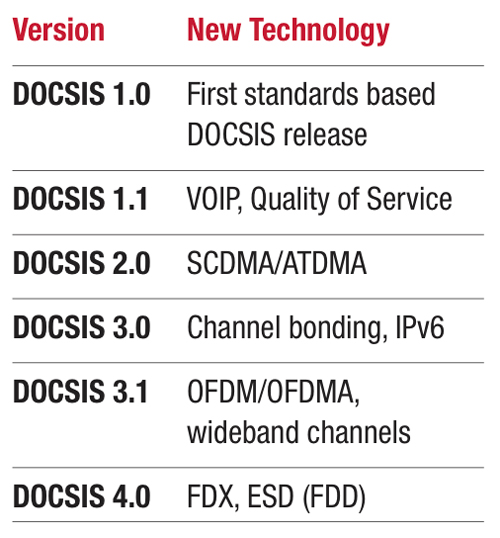The Only Impossible Journey is the One You Never Begin
By Jeff Finkelstein
“A riddle, wrapped in a mystery, inside an enigma”
— Sir Winston Churchill
“D4.0 is a riddle, wrapped in a mystery, inside an enigma, disguised as a conundrum”
— Me
By this time many of us, if not most of us, are well-versed in the DOCSIS® 4.0 conundrum. Some may say overly so. With the increasing frequency of papers, articles, and interviews related to DOCSIS 4.0, we are inundated almost daily with new information put forth. Unfortunately, a portion of that shared information is not quite accurate, which just adds to the state of confusion we find ourselves in these days.
While I am hardly a shining example of knowledge, I have been involved in DOCSIS since the mid-1990s and am one of those who created the strategy behind DOCSIS 3.1 and 4.0. As in all things, take my comments with a large grain of salt.
What is the state of the DOCSIS 4.0 nation?
Short answer: We are in a good place. In fact, a very good place.
Longer answer: Keep reading.
When we think back to prior versions of DOCSIS, each one introduced several new concepts or technologies, and DOCSIS 4.0 is no different. Think back to your beginnings in cable. How many new technologies have been introduced since then in your specific field? Is it more or less than we have seen in DOCSIS?
Putting it into perspective, the following table touches on some of the key innovations in each version of DOCSIS. Not all of course, but the main ones that were worthy of a new version number

As someone who has been involved for a long time and looking back at it now, the amount of work required to bring DOCSIS to where it is today was a large commitment of time. I have lost track of how many trips we made to CableLabs for spec work, interops, vendor meetings, and general discussions. But no matter how many times I have flown into the Denver airport, I still get excited for seeing people I respect and learn from as we develop the new standards that continue to keep cable competitive and, in many ways, better than competitive threats.
Not that it is better for everyone, just that given the long history of cable we have seen incredible growth in the potential of the cable network. We get so caught up in the nuances of cable vs. fiber vs. wireless, that we forget what amazing strides we have made.
To dig yourself out of a hole first put down the shovel
I will not delve too deeply into how difficult things have been for cable technologies the past four years, as most of us have lived through that period. What I want to discuss is how we can get out of it.
Let’s start with a brief synopsis of how we got here. We were well into the deployment of CCAP and DOCSIS 3.1 when we started the planning for DOCSIS 4.0. In hindsight we probably were a bit early in starting to talk about it publicly. When we look back at previous DOCSIS versions, the work on the next version began with discussions at CableLabs before the information got into the public domain. With DOCSIS 4.0 information was released while still discussing the technologies, which caused concern among vendors and operators that DOCSIS 3.1 investments may be “regrettable spends.” This caused a slowdown in deployments, which impacted the ecosystem and caused a bit of a kerfuffle
As we are now well into the development of DOCSIS 4.0 technologies, strategies are taking shape on how to deploy DOCSIS 3.1 to solve immediate challenges with capacity and speeds, while still laying the groundwork for future technologies. There were early discussions at various events regarding how to simplify the migration from DOCSIS 3.1 to DOCSIS 4.0, but now that we have working prototypes, we can base those strategies on the realities of how it works versus the theoretical of how we think it will work.
For example, until we recently received passive and active outside plant components, the thinking was that actives may have to be respaced. However, with prototype implementations of RPD/RMD nodes and amplifiers being able to push the envelope of performance we now know that is not needed. The deployment of DOCSIS 4.0 looks remarkably like how we have used past generations of equipment, which simplifies operational concerns. Technologies have advanced quite rapidly, much more so than many of us thought possible.
Yes, the DOCSIS 4.0 technologies are more complex, but not rocket surgery. You don’t have to be the sharpest crayon in the shed to see how it will advance cable technology to be very competitive with fiber at a lower cost.
In other words, the industry is aligning behind DOCSIS 4.0. There is no reason to feel continued angst.
The proof is in the pudding and who doesn’t like pudding?
As many of you know, there was a recent 10G showcase held at CableLabs for operators and vendors. It was a fascinating event with very interesting panels on DOCSIS 4.0 technologies, operational impacts and strategies, vendor product plans, CableLabs/SCTE/Kyrio readiness, and live product demos showing both DOCSIS 4.0 technologies working in simulated plants.
By the time you read this article, the press will have already printed what they saw. For those who may not have seen the reports and for the doubters in the crowd, the synopsis is not only does DOCSIS 4.0 work, but that it works as well as expected or better. The ESD demo showed RMD nodes with passives and actives working up to 1.8 GHz with better performance than initial models predicted, over 9 Gbps downstream and 6 Gbps upstream. The full duplex DOCSIS demo showed a vCMTS located 40 km away controlling RPD nodes and CPE, all working more efficiently than thought possible with speeds over 8 Gbps downstream and 5 Gbps upstream.
Timelines for product readiness should continue as reported in the press with DOCSIS 4.0 product availability in 2023/2024, and full-scale products ready for 2024/2025. As with any new technologies it will take a few years to achieve scale, but with the backwards compatibility built into DOCSIS 4.0 we can deploy the technologies starting with the outside plant to prep the data pathways, then move to the endpoints to stage the on- and off-ramps, then finally begin moving customers to DOCSIS 4.0 as opportunities exist or additional capacity/speeds are needed. It is not an all or nothing proposition.
The time to act is now, or at least soon
With the great work shown at the 10G showcase we know that DOCSIS 4.0 is moving at a faster pace and better performance than expected. The time to begin planning a deployment and migration strategy is now. We have a small window available to us for the pre-work, but we should not waste time concerned about the viability of DOCSIS 4.0. It not only is real, but it is here.
As we say at Cox: Act now. Be bold. Stay true.
 Jeff Finkelstein
Jeff Finkelstein
Executive Director of Advanced Technology
Cox Communications
Jeff.Finkelstein@cox.com
Jeff Finkelstein is the Executive Director of Advanced Technology at Cox Communications in Atlanta, Georgia. He has been a key contributor to the engineering organization at Cox since 2002, and led the team responsible for the deployment of DOCSIS® technologies, from DOCSIS 1.0 to DOCSIS 3.0. He was the initial innovator of advanced technologies including Proactive Network Maintenance, Active Queue Management and DOCSIS 3.1. His current responsibilities include defining the future cable network vision and teaching innovation at Cox. Jeff has over 43 patents issued or pending. His hobbies include Irish Traditional Music and stand-up comedy.
Shutterstock




